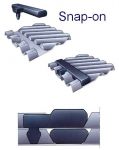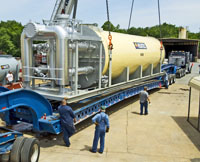You walk past one of your plate heat exchangers that’s been working great for a long time. But, today you notice that it”s leaking onto the floor in several different locations. You need this heat exchanger for a critical heating or cooling application at your facility. You can”t remember ever changing the gaskets on the unit, so you run to your office to get the records on the heat exchanger. You notice that the unit was supplied with glued gaskets…..what now?
It”s an interesting problem right? But, it happens all the time. First, let”s discuss the various gasket attachment methods utilized by the major manufacturers today. There are two (2) general styles of gasket attachment methods used on plate heat exchangers: glued and glue free.
Glue-Free Gaskets
Manufacturers have developed several ways to attach gaskets to plate heat exchanger plates without the use of gaskets over the years.


Shown above are two (2) of the most common glue-free gasket styles. The “clip on” style utilizes tabs that affix to the edges of the plates. The “snap on” style utilizes small nipples that push through tiny holes in the plates. Yet another style of “snap on” gaskets uses a crimp in the gasket channel and the gasket is pushed into place.
Glued Gaskets

Although it may sound like there is really only one style of glued gasket, the adhesive can make a big difference. There are two main styles of adhesives used to affix gaskets to plates. The first is a rubber based contact style adhesive that may or may not require heat curing. An example of such adhesives is Pliobond or others. We”ll refer to this type of adhesive bonding as “low strength”. The second type of adhesive employed is an epoxy based adhesive that must be heat cured. This type of gasket adhesive is meant to be more permanent. Generally, epoxy adhesives can only be removed by dipping the plates into liquid nitrogen.
How Do I Know What Type of Glued Gasket That I Have?
If your heat exchanger is small to medium sized (pipe connections less than 8″), from one of the major manufacturers except for Alfa Laval, then the gaskets probably have low strength glue on them. If you have glued gaskets on an Alfa Laval heat exchanger, chances are that epoxy glue was used (however, Alfa Laval doesn”t typically employ glued gaskets on units of this size unless requested).
Why Were Glued Gaskets Used?
Using glued gaskets is a good option for larger heat exchangers (greater than 10″ connections), when the end user expects to have to open and clean the exchanger frequently, the unit will operate at relatively high pressure (say above 250 psig), or there is a risk of swelling from a chemical component in the process stream. Gluing the gaskets to the plate can be helpful during frequent cleaning as the gaskets will generally stay affixed to the plates during hydroblasting.
Another reason why glued gaskets were used on your heat exchanger may simply be that the clip on style was not available from the manufacturer when your unit was made. Older plate heat exchangers tend to utilize the glued gasket system more than new units as the clip on style methods have improved over the years.
What”s Next?
So, once we”ve determined that you have a plate heat exchanger which likely has the gaskets glued onto the plates with low strength glue, how do we go about servicing such a unit? The typical option is to remove your plate pack and send it to a qualified service center. At the service center, the gaskets will be removed, the plates chemically cleaned, the plates can be dye penetrant examined to look for any holes in the plates (optional), and new gaskets glued onto the plates. The plate pack is then shipped back on site for installation into the plate heat exchanger. This entire process, with shipping time, will generally take 7 to 14 business days, but it certainly the best option if you can be without your heat exchanger for a couple of weeks.
If you have no downtime available, then servicing the heat exchanger become more interesting. Generally speaking, if a plate heat exchanger is critical enough that it cannot be down for a typical service cycle, we usually recommend the use of a spare plate pack on site to cycle into the heat exchanger. The heat exchanger plate pack can usually be changed out in 8 hours (depending on the size and number of plates). The dirty plate pack is sent off for servicing and then returned on site and held for the next maintenance cycle. The additional investment of the spare plate pack provides piece of mind that the heat exchanger should never be down for more than a few hours.
Another alternative may be to utilize a plate exchange program. If you have a relatively common heat exchanger model, we may be able to arrange to have a new or slightly used plate pack sent onsite for installation into your heat exchanger. The old plates are removed, cleaned on site, boxed, and shipped to the manufacturer where they are completely reconditioned and ready for use for the next customer (this is rather like a propane cylinder exchange).
Of course, the option always exists to simply replace your entire heat exchanger with a newer model that utilizes clip on style gaskets, but this is generally reserved for cases where the existing heat exchanger has undergone significant frame damage or is no longer suited to perform the heat transfer duty that may have increased over the years. Also, before changing to clip on style gaskets, it”s a good idea to look at the maintenance history of the heat exchanger to make sure that a clip on style gasket is appropriate for the duty. But, again, if the unit is seldom cleaned and isn”t too large, clip on gaskets will make it easier to service in the future.
Another option that may existing, but not often, is to research whether the manufacturer has introduced a clip on or snap on style gasket for your model plate heat exchanger since your unit was originally built. If clip on style gaskets are available, this may be an option as well.
The final, and least attractive option, is to regasket your plate pack at your facility to minimize downtime and cost associated with the change out. We only recommend this as a last resort. The old gaskets must be removed from the plates, the channel groves must to cleaned with acetone to remove the residue adhesive (and likely small gasket pieces), the acetone must then be wiped completely from the plate, and the new gaskets glued onto the plate. We”ve performed jobs such as this in the past, but it can require significant man power resources and close supervision to ensure a quality outcome.
Glued gaskets may not be ideal for every situation where they’ve been used, but with some planning in place, the job can go smoothly. Be sure that you know what you would do if you plate heat exchanger needed servicing tomorrow.



